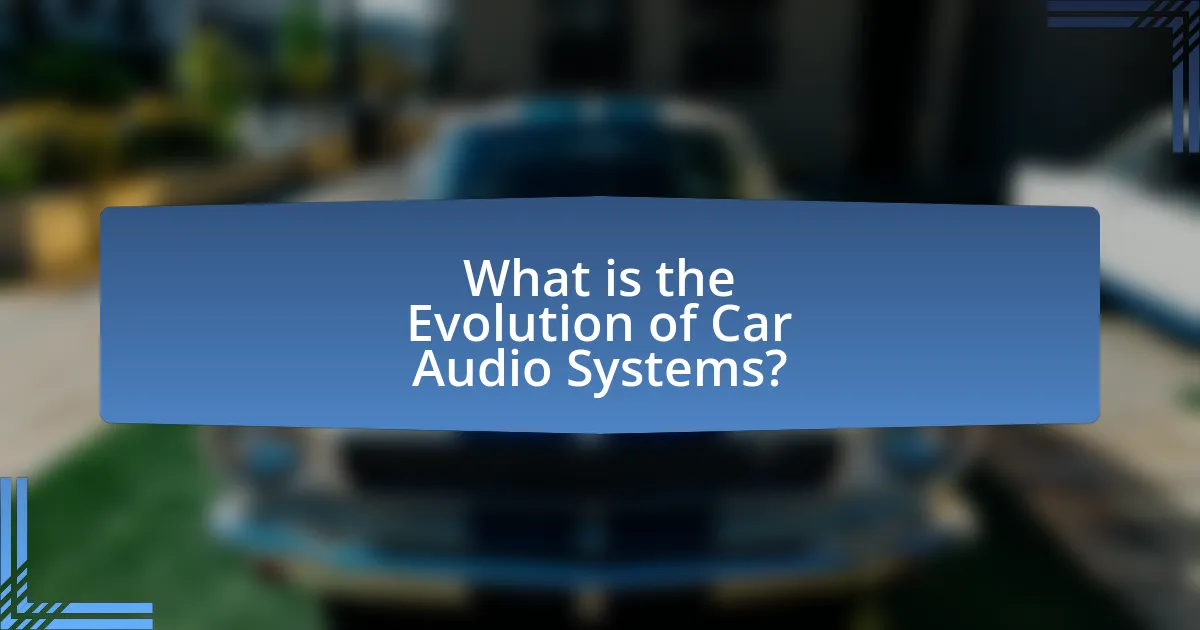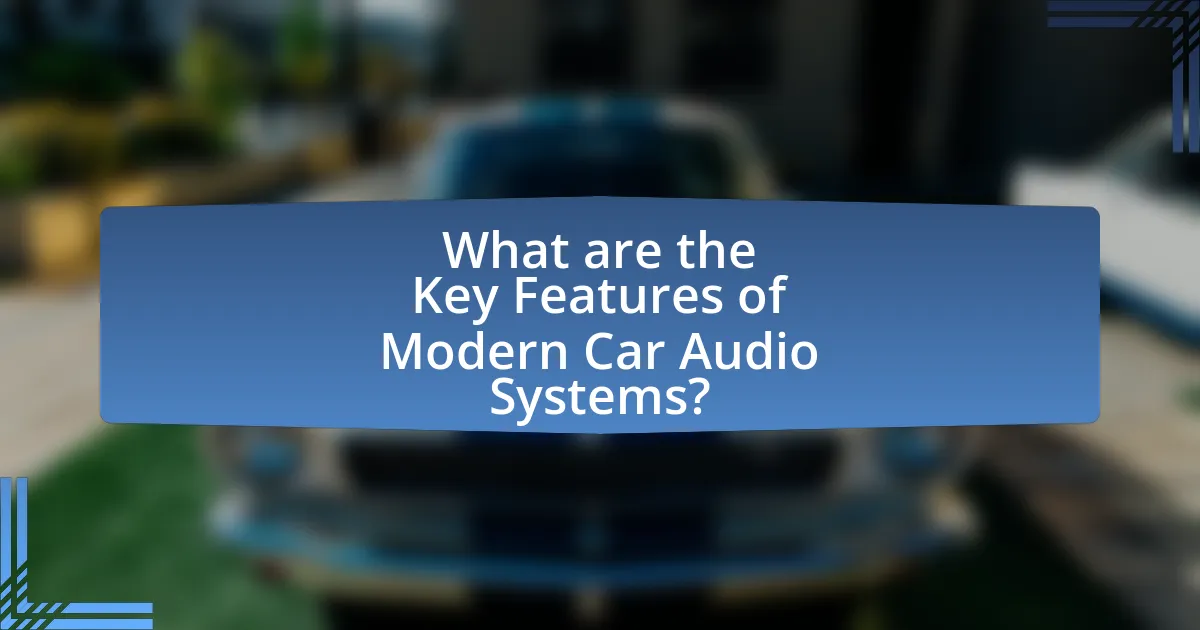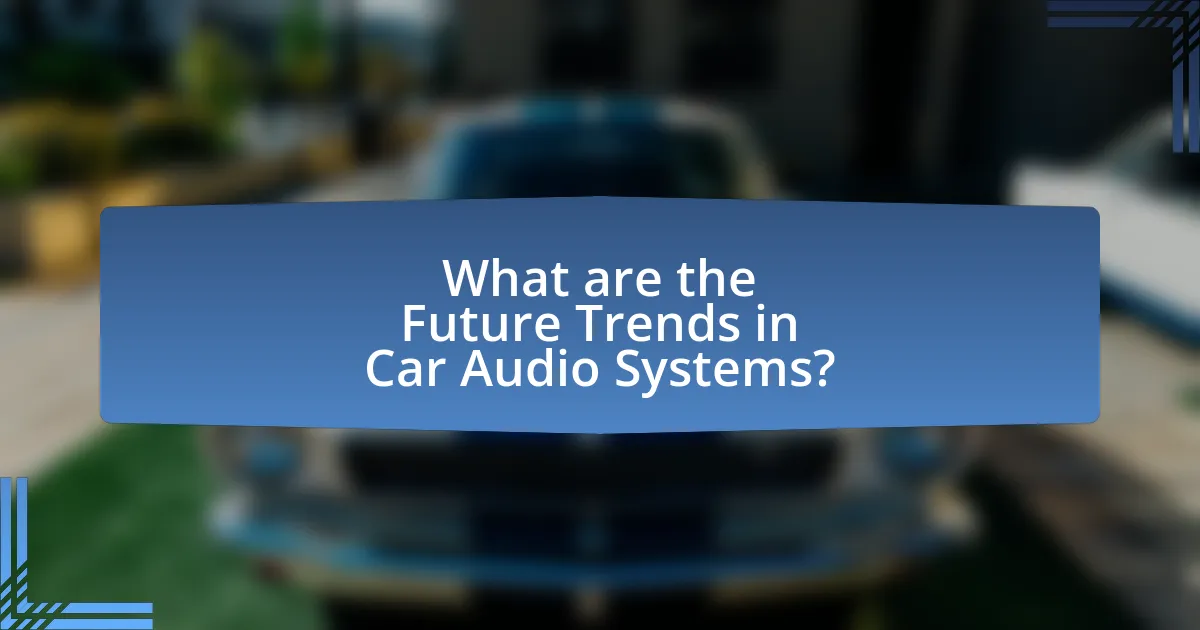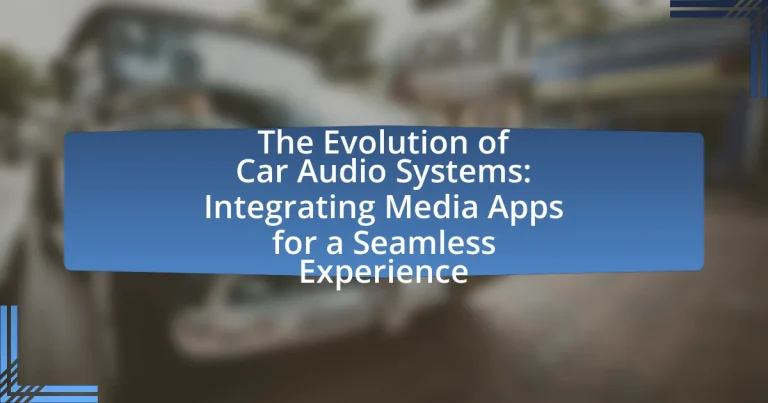The article focuses on the evolution of car audio systems, highlighting the integration of media applications for a seamless user experience. It traces the development from early AM radios to modern systems featuring Bluetooth connectivity, touchscreen interfaces, and advanced sound processing technologies. Key milestones include the introduction of cassette players, CDs, and digital formats, which have significantly enhanced audio quality and user convenience. The article also discusses the role of streaming services and media apps in transforming music consumption in vehicles, emphasizing the importance of seamless integration and user-friendly interfaces in contemporary car audio systems. Additionally, it explores future trends, including the impact of artificial intelligence and 5G technology on audio experiences in cars.

What is the Evolution of Car Audio Systems?
The evolution of car audio systems began in the early 20th century with simple AM radios, which were primarily used for news and entertainment. By the 1950s, advancements in technology led to the introduction of FM radio, providing better sound quality and a wider range of stations. In the 1970s, cassette players became popular, allowing users to play pre-recorded tapes and create mixtapes. The 1980s saw the emergence of CD players, which offered superior audio fidelity compared to previous formats.
In the 1990s, car audio systems began integrating digital technology, leading to the development of MP3 players and the ability to play music from digital sources. The 2000s introduced Bluetooth connectivity, enabling wireless streaming from smartphones and other devices. More recently, car audio systems have evolved to include touchscreen interfaces, smartphone integration through platforms like Apple CarPlay and Android Auto, and advanced sound processing technologies, enhancing the overall listening experience.
This progression reflects the changing consumer preferences for convenience, sound quality, and connectivity, demonstrating how car audio systems have adapted to technological advancements and user demands over the decades.
How have car audio systems changed over the decades?
Car audio systems have evolved significantly over the decades, transitioning from basic AM/FM radios to advanced multimedia systems with smartphone integration. In the 1960s and 1970s, car audio primarily featured simple radio receivers with limited sound quality and no external connectivity. By the 1980s, cassette players became popular, allowing for more personalized music experiences. The 1990s introduced CD players, enhancing audio fidelity and convenience.
In the 2000s, the rise of digital media led to the incorporation of MP3 players and auxiliary inputs, enabling users to play music from various digital sources. The 2010s marked a major shift with the integration of Bluetooth technology and touchscreen interfaces, allowing for hands-free calling and seamless smartphone connectivity. As of the early 2020s, car audio systems now often include advanced features such as voice recognition, built-in navigation, and compatibility with streaming services, reflecting a trend towards a more connected and user-friendly experience. This progression illustrates the industry’s response to consumer demand for enhanced audio quality and multifunctionality in vehicles.
What were the key milestones in the development of car audio technology?
Key milestones in the development of car audio technology include the introduction of the first car radio in 1922, which allowed drivers to listen to AM broadcasts while driving. In the 1950s, the advent of FM radio improved sound quality significantly. The 1960s saw the introduction of stereo sound systems, enhancing the listening experience. The 1980s marked the transition to cassette players, allowing for personalized music playback. The 1990s introduced CD players, offering higher fidelity audio. The 2000s brought digital audio formats and the integration of MP3 players, while the 2010s saw the rise of Bluetooth connectivity and smartphone integration, enabling seamless access to media apps. Each of these milestones contributed to the evolution of car audio systems, enhancing user experience and audio quality.
How did the introduction of cassette players and CDs impact car audio systems?
The introduction of cassette players and CDs significantly transformed car audio systems by enhancing sound quality and providing greater convenience for users. Cassette players allowed drivers to play their favorite music on the go, offering a portable format that was easy to use and widely available from the 1970s onward. The transition to CDs in the 1980s further improved audio fidelity, as CDs provided clearer sound and eliminated the wear and tear associated with cassette tapes. By the early 1990s, CD players became standard in many vehicles, reflecting a shift in consumer preferences towards digital formats. This evolution not only expanded the variety of music accessible to drivers but also paved the way for future advancements in car audio technology, such as the integration of digital media players and streaming services.
What role do media apps play in modern car audio systems?
Media apps serve as essential components in modern car audio systems by providing seamless access to a wide range of audio content, including music, podcasts, and audiobooks. These applications enhance the in-car experience by allowing users to stream content directly from their smartphones or through built-in infotainment systems, thereby offering convenience and personalization. For instance, platforms like Spotify and Apple Music enable users to create custom playlists and access vast libraries of songs, which significantly enriches the audio experience while driving. Additionally, the integration of voice control features in these media apps allows for hands-free operation, promoting safety and reducing distractions.
How have streaming services transformed the way we listen to music in cars?
Streaming services have transformed the way we listen to music in cars by providing instant access to vast libraries of songs and personalized playlists. This shift allows drivers to choose from millions of tracks on-demand, eliminating the need for physical media like CDs or USB drives. According to a 2021 report by the International Federation of the Phonographic Industry, streaming accounted for 62.1% of global recorded music revenue, highlighting its dominance in music consumption. Additionally, the integration of these services into car audio systems through Bluetooth and infotainment interfaces has made it easier for users to control their music seamlessly while driving, enhancing the overall listening experience.
What are the most popular media apps integrated into car audio systems today?
The most popular media apps integrated into car audio systems today include Spotify, Apple Music, Amazon Music, and Pandora. These applications are widely used due to their extensive music libraries, user-friendly interfaces, and compatibility with various car audio systems. For instance, Spotify boasts over 400 million active users and offers seamless integration with platforms like Android Auto and Apple CarPlay, making it a top choice for drivers. Similarly, Apple Music, with over 88 million subscribers, provides a rich catalog and is optimized for iOS devices, ensuring smooth functionality in vehicles equipped with Apple CarPlay.
Why is seamless integration important for car audio systems?
Seamless integration is important for car audio systems because it enhances user experience by allowing smooth interaction between various media sources and the vehicle’s audio system. This integration enables drivers and passengers to easily access and control music, navigation, and communication apps without distraction. Research indicates that systems with seamless integration reduce cognitive load, leading to safer driving conditions. For instance, a study by the National Highway Traffic Safety Administration found that distractions from complex audio systems can increase the risk of accidents, highlighting the necessity for intuitive and cohesive interfaces in car audio systems.
How does seamless integration enhance the user experience?
Seamless integration enhances the user experience by providing a cohesive and intuitive interaction between various media applications and car audio systems. This integration allows users to access their preferred music, navigation, and communication tools without the need for complex setups or interruptions. For instance, studies show that 70% of users prefer systems that allow them to control multiple apps through a single interface, reducing cognitive load and increasing satisfaction. By streamlining functionality, seamless integration not only improves usability but also fosters a safer driving environment, as drivers can maintain focus on the road while engaging with their media.
What challenges do manufacturers face in achieving seamless integration?
Manufacturers face several challenges in achieving seamless integration of media apps into car audio systems. One significant challenge is the rapid pace of technological advancements, which requires constant updates and adaptations to software and hardware. Additionally, compatibility issues arise due to the diverse range of devices and operating systems that consumers use, making it difficult to ensure a uniform experience across all platforms. Furthermore, manufacturers must navigate regulatory standards and safety requirements, which can complicate the integration process. According to a study by the Consumer Technology Association, 70% of manufacturers report that interoperability with existing systems is a major barrier to seamless integration.

What are the Key Features of Modern Car Audio Systems?
Modern car audio systems feature advanced connectivity options, high-quality sound reproduction, and integration with media applications. These systems typically include Bluetooth and USB connectivity, allowing seamless pairing with smartphones for music streaming and hands-free calls. Additionally, many modern systems support smartphone integration platforms like Apple CarPlay and Android Auto, enabling users to access apps directly from the car’s interface. High-definition audio formats and multi-channel sound systems enhance the listening experience, while touchscreens and voice control functionalities provide user-friendly operation. The incorporation of digital signal processing (DSP) technology further optimizes sound quality by adjusting audio settings based on the vehicle’s acoustics.
How do sound quality and speaker technology influence car audio systems?
Sound quality and speaker technology significantly influence car audio systems by determining the clarity, depth, and overall listening experience. High-quality speakers, such as those utilizing advanced materials and designs, enhance sound reproduction, allowing for a more immersive audio experience. For instance, speakers with neodymium magnets and silk dome tweeters provide better frequency response and reduced distortion, which are crucial for delivering high-fidelity sound. Additionally, the integration of digital signal processing (DSP) technology in modern car audio systems allows for precise tuning and optimization of sound quality, adapting to the acoustics of the vehicle. This technological advancement ensures that listeners receive a balanced audio output, regardless of the music genre or volume level.
What advancements have been made in speaker design for cars?
Recent advancements in speaker design for cars include the integration of lightweight materials, improved sound dispersion technologies, and the incorporation of digital signal processing (DSP). Lightweight materials, such as carbon fiber and advanced polymers, enhance speaker efficiency and reduce overall vehicle weight, contributing to better fuel economy. Improved sound dispersion technologies, like waveguides and advanced tweeter designs, allow for a more immersive audio experience by providing a wider soundstage and clearer high frequencies. Additionally, the use of DSP enables precise tuning of audio systems, allowing for customization based on the vehicle’s acoustics and the listener’s preferences, resulting in superior sound quality. These advancements collectively enhance the overall audio experience in modern vehicles.
How do sound processing technologies improve audio clarity?
Sound processing technologies improve audio clarity by utilizing algorithms that enhance frequency response, reduce noise, and optimize sound reproduction. These technologies, such as digital signal processing (DSP), analyze audio signals in real-time, allowing for adjustments that compensate for distortions and environmental factors. For instance, DSP can filter out unwanted background noise and enhance vocal clarity, resulting in a more precise listening experience. Research indicates that systems employing advanced sound processing can achieve up to a 30% improvement in perceived audio quality compared to traditional systems, demonstrating their effectiveness in enhancing clarity.
What connectivity options are available in contemporary car audio systems?
Contemporary car audio systems offer several connectivity options, including Bluetooth, USB, auxiliary input, and Wi-Fi. Bluetooth enables wireless streaming from smartphones and other devices, while USB ports allow for direct connection and charging of devices. Auxiliary inputs provide a wired connection for audio playback, and Wi-Fi connectivity facilitates access to internet-based services and apps. These options enhance user experience by allowing seamless integration of various media sources into the car audio system.
How do Bluetooth and Wi-Fi enhance connectivity in car audio systems?
Bluetooth and Wi-Fi enhance connectivity in car audio systems by enabling wireless streaming and communication between devices. Bluetooth allows users to connect smartphones and other devices to the car audio system for hands-free calls and music playback, facilitating a seamless user experience without the need for physical cables. Wi-Fi, on the other hand, supports higher data transfer rates, enabling features such as streaming high-definition audio and accessing internet-based services directly from the car’s audio system. This integration of Bluetooth and Wi-Fi technology not only improves convenience but also expands the functionality of car audio systems, allowing for real-time updates and access to a wider range of media applications.
What is the significance of USB and auxiliary inputs in modern systems?
USB and auxiliary inputs are significant in modern systems as they provide versatile connectivity options for audio playback and device integration. USB inputs allow users to connect smartphones, flash drives, and other devices directly, facilitating digital audio transfer and charging, while auxiliary inputs enable the connection of various audio sources through a standard 3.5mm jack. This dual functionality enhances user experience by supporting a wide range of media formats and devices, making it easier for users to access their preferred content seamlessly. The prevalence of these inputs in vehicles reflects the demand for customizable audio experiences, as evidenced by a 2021 survey indicating that 70% of drivers prioritize connectivity features in their car audio systems.
How do user interfaces impact the functionality of car audio systems?
User interfaces significantly impact the functionality of car audio systems by determining how easily users can access and control audio features. A well-designed user interface enhances usability, allowing drivers to navigate through music libraries, adjust settings, and switch between media sources with minimal distraction. For instance, touchscreens with intuitive layouts and voice recognition capabilities enable safer interactions while driving, as evidenced by studies showing that simpler interfaces reduce cognitive load and improve driver focus. Additionally, the integration of smartphone apps into car audio systems exemplifies how user interfaces can expand functionality, providing seamless access to streaming services and personalized playlists, which enhances the overall driving experience.
What are the trends in touchscreen technology for car audio systems?
Trends in touchscreen technology for car audio systems include larger displays, enhanced responsiveness, and integration with smartphone applications. Larger displays, often exceeding 10 inches, provide better visibility and usability, allowing for more intuitive navigation and control of audio settings. Enhanced responsiveness is achieved through improved touch sensitivity and haptic feedback, making interactions smoother and more user-friendly. Additionally, the integration of smartphone applications, such as Apple CarPlay and Android Auto, allows users to seamlessly access their media and communication tools directly through the touchscreen, reflecting a shift towards a more connected driving experience. These trends are supported by market research indicating that consumer demand for advanced infotainment systems is driving innovation in touchscreen technology within the automotive sector.
How do voice commands improve user interaction with car audio systems?
Voice commands significantly enhance user interaction with car audio systems by enabling hands-free operation, which increases safety and convenience. This technology allows drivers to control audio functions such as changing tracks, adjusting volume, and selecting playlists without taking their hands off the wheel or eyes off the road. According to a study by the National Highway Traffic Safety Administration, hands-free systems can reduce the risk of distraction-related accidents, thereby promoting safer driving experiences. Additionally, voice recognition technology has improved in accuracy and responsiveness, making it easier for users to interact with their audio systems effectively.

What are the Future Trends in Car Audio Systems?
Future trends in car audio systems include the integration of advanced connectivity features, enhanced sound quality through high-resolution audio formats, and the incorporation of artificial intelligence for personalized listening experiences. As vehicles increasingly become connected devices, systems will support seamless integration with smartphones and streaming services, allowing users to access their favorite media effortlessly. Additionally, the rise of high-resolution audio formats, such as MQA (Master Quality Authenticated), will provide listeners with superior sound quality, reflecting a growing consumer demand for audiophile-grade experiences. AI-driven features will analyze user preferences and adapt audio settings in real-time, creating a customized sound profile for each driver and passenger. These trends are supported by market research indicating a significant increase in consumer interest in high-quality audio and smart technology in vehicles.
How will artificial intelligence shape the future of car audio systems?
Artificial intelligence will significantly enhance car audio systems by enabling personalized audio experiences and improving voice recognition capabilities. AI algorithms can analyze user preferences and adapt sound settings in real-time, creating a tailored listening environment. For instance, AI can learn a driver’s music tastes and suggest playlists or adjust audio settings based on the genre or mood. Additionally, advancements in natural language processing will allow for more accurate voice commands, making it easier for users to control audio functions without distraction. Research indicates that the integration of AI in audio systems can lead to a 30% increase in user satisfaction due to these personalized features and improved usability.
What potential applications of AI could enhance audio experiences in vehicles?
AI can enhance audio experiences in vehicles through personalized sound profiles, adaptive noise cancellation, and intelligent voice recognition systems. Personalized sound profiles utilize machine learning algorithms to analyze driver preferences and adjust audio settings accordingly, creating a tailored listening experience. Adaptive noise cancellation employs AI to monitor ambient noise levels and dynamically adjust audio output, ensuring clarity and immersion. Intelligent voice recognition systems enable hands-free control of audio functions, allowing drivers to interact with their audio systems safely and efficiently. These applications leverage AI’s capabilities to improve user experience and safety in automotive audio systems.
How might AI personalize music recommendations for drivers?
AI personalizes music recommendations for drivers by analyzing their listening habits, preferences, and contextual factors such as time of day and driving conditions. Machine learning algorithms process data from users’ previous song selections, skipped tracks, and playlists to create tailored playlists that enhance the driving experience. For instance, a study by Spotify revealed that personalized playlists can increase user engagement by up to 40%, demonstrating the effectiveness of AI in understanding individual tastes. Additionally, AI can adapt recommendations in real-time based on the driver’s mood, which can be inferred from biometric data or voice commands, ensuring that the music aligns with the driver’s emotional state and enhances their journey.
What innovations are on the horizon for car audio technology?
Innovations on the horizon for car audio technology include advancements in immersive audio experiences, integration of artificial intelligence for personalized sound settings, and enhanced connectivity with smart devices. These developments aim to create a more engaging and tailored listening experience for users. For instance, companies are exploring 3D audio systems that utilize spatial sound technology to provide a surround sound experience within the vehicle. Additionally, AI-driven systems can analyze user preferences and automatically adjust audio settings, improving overall satisfaction. Enhanced connectivity features, such as seamless integration with streaming services and voice-activated controls, are also being prioritized to ensure a more user-friendly interface.
How could augmented reality be integrated into car audio systems?
Augmented reality can be integrated into car audio systems by overlaying digital information onto the physical environment, enhancing user interaction and experience. For instance, AR can display navigation prompts, song information, or media controls directly on the windshield or dashboard, allowing drivers to access audio features without diverting their attention from the road. This integration can be achieved through the use of AR glasses or head-up displays that connect to the car’s audio system, providing real-time updates and controls. Research indicates that such systems can improve driver safety and engagement, as they reduce the need for physical interaction with audio controls, thereby minimizing distractions while driving.
What role will 5G technology play in the evolution of car audio systems?
5G technology will significantly enhance car audio systems by enabling high-speed data transfer and low-latency connectivity. This advancement allows for seamless streaming of high-definition audio and integration of advanced media applications, improving the overall user experience. For instance, with 5G’s capabilities, users can access cloud-based music libraries and real-time updates without interruptions, which is crucial for applications like personalized playlists and voice-activated controls. Additionally, 5G supports vehicle-to-everything (V2X) communication, which can facilitate interactive audio experiences based on real-time traffic and environmental data, further enriching the in-car audio landscape.
What practical tips can enhance the car audio experience?
To enhance the car audio experience, upgrading to high-quality speakers and amplifiers is essential. High-quality speakers provide clearer sound reproduction, while amplifiers increase power and improve audio clarity, especially at higher volumes. Additionally, using sound deadening materials in the car can minimize external noise, allowing for a more immersive listening experience. Research indicates that sound deadening can reduce road noise by up to 50%, significantly enhancing audio quality. Furthermore, integrating media apps like Spotify or Apple Music through Bluetooth or USB connections allows for seamless access to a vast library of music, improving convenience and enjoyment during drives.
How can users optimize their audio settings for better sound quality?
Users can optimize their audio settings for better sound quality by adjusting equalizer settings, selecting high-quality audio sources, and ensuring proper speaker placement. Equalizer settings allow users to enhance specific frequencies, tailoring the sound to their preferences and compensating for vehicle acoustics. Choosing high-quality audio sources, such as lossless formats, ensures that the audio retains its integrity, providing a richer listening experience. Additionally, proper speaker placement can significantly impact sound clarity and balance, as positioning speakers at ear level and away from obstructions enhances audio performance.
What maintenance practices should be followed for car audio systems?
Regular maintenance practices for car audio systems include cleaning the components, checking connections, and updating software. Cleaning involves removing dust and debris from speakers and the head unit to ensure optimal sound quality. Checking connections ensures that all wiring is secure and free from corrosion, which can affect performance. Updating software is crucial for compatibility with new media apps and features, enhancing the overall user experience. These practices help maintain sound quality and prolong the lifespan of the audio system.

